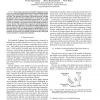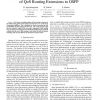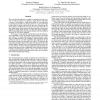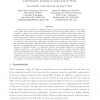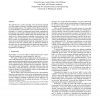INFOCOM
1999
IEEE
14 years 4 months ago
1999
IEEE
We are facing a growing user demand for ubiquitous Internet access. As a result, network ports and wireless LANs are becoming common in public spaces inside buildings such as loung...
INFOCOM
1999
IEEE
14 years 4 months ago
1999
IEEE
We discuss an implementation of QoS routing extensions to the OSPF routing protocol and evaluate its performance over a wide range of operating conditions. Our evaluations are aime...
INFOCOM
1999
IEEE
14 years 4 months ago
1999
IEEE
Multiband (or multi-carrier) CDMA is a promising approach to increasing the capacity of CDMA networks, while maintaining compatibility with existing systems. This paper investigate...
SIGCOMM
1999
ACM
14 years 4 months ago
1999
ACM
The conventional approach to routing in computer networks consists of using a heuristic to compute a single shortest path from a source to a destination. Single-path routing is ve...
SIGCOMM
1999
ACM
14 years 4 months ago
1999
ACM
SIGCOMM
1999
ACM
14 years 4 months ago
1999
ACM
Internet service providers face a daunting challenge in provisioning network resources, due to the rapid growth of the Internet and wide fluctuations in the underlying traffic pa...
SIGCOMM
1999
ACM
14 years 4 months ago
1999
ACM
The path taken by a packet traveling across the Internet depends on a large number of factors, including routing protocols and pernetwork routing policies. The impact of these fac...
SIGCOMM
1999
ACM
14 years 4 months ago
1999
ACM
Many de nitions of fairness for multicast networks assume that sessions are single-rate, requiring that each multicast session transmits data to all of its receivers at the same r...
SIGCOMM
1999
ACM
14 years 4 months ago
1999
ACM
Streaming audio and video applications are becoming increasingly popular on the Internet, and the lack of effective congestion control in such applications is now a cause for sign...
SIGCOMM
1999
ACM
14 years 4 months ago
1999
ACM
Prolac is a new statically-typed, object-oriented language for network protocol implementation. It is designed for readability, extensibility, and real-world implementation; most ...
